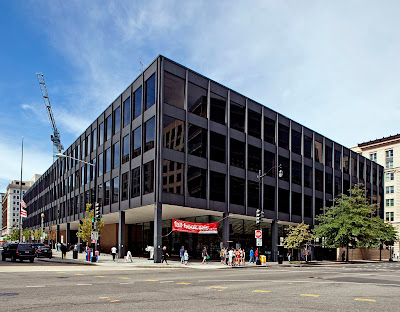Modern art
Makes me
Want to rock out!
In 1921, a German psychiatrist published a book about a psychotic patient of his named Adolf Wölfli, who created an illustrated epic biography that was 25,000 pages long and included 1600 illustrations and 1500 collages.
The next year, another German psychiatrist published a book titled Artistry of the Mentally Ill, which got a lot of attention from avant-garde artists -- including the French painter and sculptor Jean Dubuffet, who coined the term art brut (or "raw art") to describe art created not only by inmates of insane asylums but also works by outsider artists who have no contact with the mainstream art world.
Dubuffet believed that art brut -- which was "created from solitude and pure and authentic creative impulses" -- was "more precious than the productions of professionals" who are associated with art schools, galleries, museums and the other institutions of official culture.
 |
| "Welcome Parade," by Jean Dubuffet |
One of my favorite "outsider" artists was James Hampton, a government janitor who spent the last 14 years of his life creating "The Throne of the Third Heaven of the Nations' Millennium General Assembly," which consists of 180 objects Hampton had made from junk -- broken furniture, cardboard, aluminum foil, burned-out light bulbs, etc.
Amazingly, Hampton's work wasn't just dragged off to the dump. Instead, it came into the possession of the Smithsonian American Art Museum several years after Hampton died in 1964.
Here is a sampling of Hampton's 180-piece work:
Hampton also left behind a 108-page notebook written mostly in an unknown script that has yet to be deciphered. Here's a portion of one page:
There's plenty of art around today that's as crazy as anything Adolf Wölfli and his fellow insane-asylum residents created. But many of those works are created by art-school graduates and funded by government agencies and nonprofit foundations, and so are as far from art brut as it gets.
 |
| The Martin Luther King Jr. Memorial Library |
One place to see such art is the central Washington, DC public library is the 400,000 square foot Martin Luther King Jr. Memorial Library, which is located two blocks from my office in downtown Washington.
The King library was designed by the famed modern architect Mies van der Rohe, who is best known for the Seagram Building in New York City and for two oft-quoted aphorisms: "Less is more," and "God is in the details."
 |
| The Seagram Building was built in 1958 |
The MLK Library got a little seedy over the years. (It attracts a fair number of homeless men, especially during the winter.) The city skimped on maintenance, and the building suffered from broken elevators, missing ceiling tiles, and malfunctioning HVAC.
A few years ago, the city wanted to tear the MLK Library down and build a new main library. Historic preservationists opposed the building's demolition, and they eventually prevailed. Major renovations are now being undertaken, and the library is looking much better -- although they have a lot of work to do.
The MLK Library has a number of Mies van der Rohe's so-called Barcelona chairs, which he originally designed for the German pavilion at a 1929 international exposition in Barcelona, Spain:
 |
| Barcelona chair |
The MLK Library has a vast and almost empty entrance lobby, which is often used for art exhibits.
Here's the current exhibit, which features Sam Scharf's "Growth," a geometric installation constructed from drywall panels. According to a library brochure, "The artwork responds to the vastness of the lobby and encourages visitors to stop and ponder the ambiguous object that occupies this public space."
 |
| "Growth," by Sam Scharf |
When I saw the piece, I said to myself, 'What the hell is that?" I guess that qualifies as stopping and pondering the "ambiguous object" that the artists created.
The preceding exhibit was "Circuit," a participatory piece by Brian Davis. "Circuit" consisted of five dissimilar and banged-up chairs facing outward in a circle. Above each chair were light fixtures.
 |
| "Circuit," by Bryan Davis |
Library patrons were invited to sit in the chairs. I think the lights were supposed to start going on an off when people sat in the chairs. But when I sat in two different chairs in turn, nothing happened.
Art Brut is an art-punk band that was formed in South London ten years ago, but is now based in Berlin. Their songs are très ironique, boys and girls. (If irony was a liquid, Art Brut would likely have drowned in it by now.)
"Modern Art" is from the group's first studio album, Bang Bang Rock & Roll, which was released in 2006.
Lead singer Eddie Argos (real name: Kevin Macklin) is also the lead singer of a musical "project" called Everybody Was in the French Resistance . . . Now!, which is without a doubt the most clever band name I've ever heard.
Lead singer Eddie Argos (real name: Kevin Macklin) is also the lead singer of a musical "project" called Everybody Was in the French Resistance . . . Now!, which is without a doubt the most clever band name I've ever heard.
Here's "Modern Art":
Click here to buy the song from Amazon:






"Everyone Was in the French Resistance"--it's now safe to say that, with the Third Reich in the proverbial "dust bin of history". 70 years ago, being identified as a member of The Resistance was like signing a death warrant.
ReplyDelete